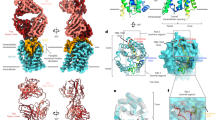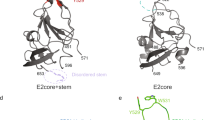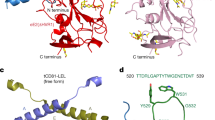Abstract
Efficient transfer of proteins or nucleic acids across cellular membranes is a major problem in cell biology. Recently the existence of a fusogenic sequence was predicted in the junction area of the PreS2- and S-domain of the hepatitis-B virus surface antigens. We have identified cell permeability as a novel property of the PreS2-domain. Cell permeability of PreS2 is not restricted to hepatocytes. PreS2 translocates in an energy-independent manner into cells and is evenly distributed over the cytosol. Detailed analysis revealed that cell-permeability is mediated by an amphipatic α-helix between amino acids 41 and 52 of PreS2. Destruction of this translocation motif (PreS2-TLM) abolishes cell permeability. PreS2-TLM per se can act as a shuttle for peptides and functional proteins (such as EGFP). This permits the highly specific modulation of intracellular signal transduction by transfer of peptides competing protein–protein interactions as demonstrated by specific inhibition of TNFα-dependent activation of c-Raf-1 kinase. Moreover in vivo functionality was demonstrated by PreS2-TLM-dependent protein transfer into primary bone marrow cells and into the liver. The amphipatic motif is conserved between the different hepatitis-B virus subtypes, and the surface proteins of avian and rodent hepadnaviruses exhibit similar amphipatic peptide sequences. In respect to hepatitis-B virus-infection, the PreS2-TLM could represent the postulated fusion peptide and play a crucial role in the internalization of the viral particle.
This is a preview of subscription content, access via your institution
Access options
Subscribe to this journal
Receive 12 print issues and online access
$259.00 per year
only $21.58 per issue
Buy this article
- Purchase on Springer Link
- Instant access to full article PDF
Prices may be subject to local taxes which are calculated during checkout









Similar content being viewed by others
References
Derossi D, Joliot AH, Chassaing G, Prochiantz A . The third helix of the antennapedia homeodomain translocates through biological membranes J Biol Chem 1994 269: 10444–10450
Vivès E, Brodin P, Lebleu B . A truncated HIV-1 Tat protein basic domain rapidly translocates through the plasma membrane and accumulates in the cell nucleus J Biol Chem 1997 272: 16010–16017
Rojas M, Donahue JP, Tan Z, Lin Y-Z . Genetic engineering of proteins with cell membrane permeability Nature Biotechnol 1998 16: 370–375
Elliot G, O'Hare P . Intercellular trafficking and protein delivery by a herpesvirus structural protein Cell 1997 88: 223–233
Phelan A, Elliott G, O'Hare P . Intercellular delivery of functional p53 by the herpesvirus protein VP22 Nature Biotechnol 1998 16: 440–443
Derossi D et al. Cell internalization of the third helix of the antennapedia homeodomain is receptor-independent J Biol Chem 1996 271: 18188–18193
Berlose J-P et al. Conformational and associate behaviours of the third helix of antennapedia homeodomain in membrane mimetic environments Eur J Biochem 1996 242: 372–386
Gerlich WH, Lu X, Heermann KH . Studies on the attachment and penetration of hepatits B virus J Hepatol 1993 17: (Suppl.3) S10–S14
Lu X, Block TM, Gerlich WH . Protease-induced infectivity of hepatitis-B virus for a human hepatoblastome cell line J Virol 1996 70: 2277–2285
Prange R, Streek R . Novel transmembrane topology of the hepatitis B virus envelop proteins EMBO J 1995 14: 247–256
Bruss V, Lu R, Thomssen R, Gerlich W . Post translational alterations in the transmembrane topology of the hepatitis-B virus large envelope protein EMBO J 1994 13: 2273–2279
Ostapchuk P, Hearing P, Ganem D . A dramatic shift in the transmembrane topology of a viral envelope glycoprotein accompanies hepatitis B viral morphogenesis EMBO J 1994 13: 1048–1057
Hildt E, Urban S, Hofschneider PH . Characterization of essential domains for the functionality of the MHBst transcriptional activator and identification of a minimal MHBst transactivator Oncogene 1995 11: 2055–2066
Hildt E, Saher G, Bruss V, Hofschneider PH . The hepatitis-B virus surface protein (LHBs) is a transcriptional activator Virology 1996 225: 235–239
Hildt E, Hofschneider PH . The PreS2-activators of the hepatitis-B virus: activators of tumour promotor pathways Rec Res Cancer Res, 1998 154: 315–329
Pastan IH, Willingham MC . Journey to the center of the cell: role of the receptosome Science 1981 214: 504–509
Hildt E, Oess S . Identification of Grb2 as a novel binding partner of tumor necrosis factor (TNF) receptor I J Exp Med 1999 189: 1707–1714
Williams EJ et al. Selective inhibition of growth factor-stimulated mitogenesis by a cell-permeable Grb2-binding peptide J Biol Chem 1997 272: 22349–22354
Schutze-Redelmeier M-P et al. Introduction of exogenous antigens into the MHC class I processing and presentation pathway by drosophila antennapedia homeodomain primes cytotoxic T cells in vivo J Immunol 1996 157: 650–655
Lin YZ et al. Inhibition of nuclear translocation of transcription factor NF-kB by a synthetic peptide containing a cell membrane-permeable motif and nuclear localisation sequence J Biol Chem 1995 270: 14255–14258
Allinquant B et al. Downregulation of amyloid precursor protein inhibits neurite outgrowth in vitro J Cell Biol 1995 128: 919–927
Troy CM et al. Downregulation of Cu/Zn superoxide dismutase leads to cell death via the nitric oxide-peroxynitrite pathway J Neurosci 1996 16: 253–261
Troy CM et al. The contrasting role of ICE family proteases and interleukin-1beta in apoptosis induced by trophic factor withdrawal and by copper/zinc superoxide dismutase downregulation Proc Natl Acad Sci USA 1996 93: 5635–5640
Pooga M et al. Cell penetrating PNA constructs regulate galanin receptor levels and modify pain transmission in vivo Nature Biotechnol 1998 16: 857–861
Hildt E et al. ER-localisation and functional expression of HBV transactivator MHBst Oncogene 1993 8: 3359–3367
Bruss V, Ganem D . The role of envelope proteins in hepatitis-B virus assembly Proc Natl Acad Sci USA 1991 88: 1059–1063
Dignam JP, LeBovitz RM, Roeder RG . Accurate transcription initiation by RNA polymerase II in a soluble extract from isolated mammalian nuclei Nucleic Acid Res 1983 11: 1475–1489
Kyte J, Doolittle RP . A simple method for displaying the hydropathic character of a protein J Mol Biol 1982 157: 105–132
Acknowledgements
Antibodies were kindly provided by Dr L Mimms, Chicago (HBV 25–19), Professor W Gerlich, Gieβen (Q19–10) and Dr A Budkowska, Paris (F124). We thank Dr C Plank, Institute for Experimental Oncology, Munich, for peptide synthesis, Professor M Wink, Department for Pharmaceutical Biology, Heidelberg, for callus cultures of lupinus albus and his kind invitation to carry out the experiments in his laboratory and Dr B Munz, Stanford, for helpful discussion. We are indebted to Professor PH Hofschneider, Martinsried, for his continuous generous support. This work was supported by the Deutsche Stiftung für Krebsforschung and the MMW (Munich).
Author information
Authors and Affiliations
Rights and permissions
About this article
Cite this article
Oess, S., Hildt, E. Novel cell permeable motif derived from the PreS2-domain of hepatitis-B virus surface antigens. Gene Ther 7, 750–758 (2000). https://doi.org/10.1038/sj.gt.3301154
Received:
Accepted:
Published:
Issue Date:
DOI: https://doi.org/10.1038/sj.gt.3301154
Keywords
This article is cited by
-
Cell-permeable capsids as universal antigen carrier for the induction of an antigen-specific CD8+ T-cell response
Scientific Reports (2017)
-
Development of Rous sarcoma Virus-like Particles Displaying hCC49 scFv for Specific Targeted Drug Delivery to Human Colon Carcinoma Cells
Pharmaceutical Research (2015)
-
Hypoxia-induced human endonuclease G expression suppresses tumor growth in a xenograft model
Cancer Gene Therapy (2008)
-
Genome-wide characterisation of Hepatitis B mutations involved in clinical outcome
Heredity (2006)
-
Reconstitution of gene expression from a regulatory‐protein‐deficient hepatitis B virus genome by cell‐permeable HBx protein
EMBO reports (2003)



